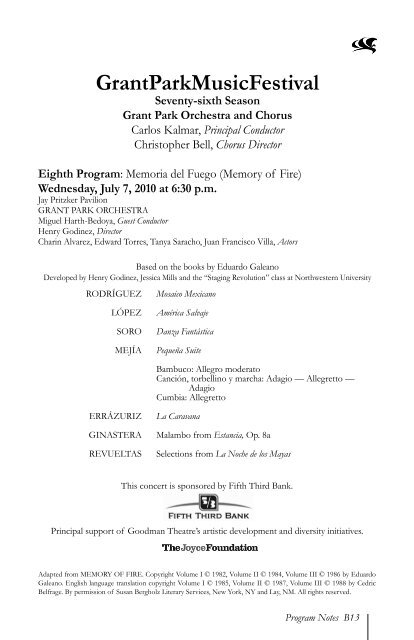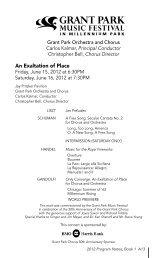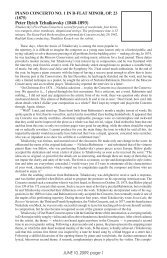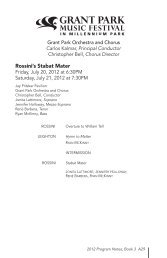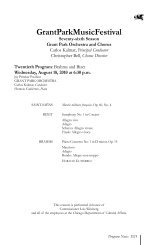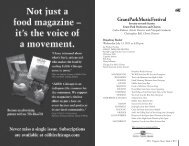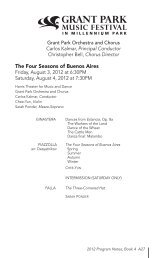Program Notes PDF - The Grant Park Music Festival
Program Notes PDF - The Grant Park Music Festival
Program Notes PDF - The Grant Park Music Festival
Create successful ePaper yourself
Turn your PDF publications into a flip-book with our unique Google optimized e-Paper software.
<strong>Grant</strong><strong>Park</strong><strong>Music</strong><strong>Festival</strong><br />
Seventy-sixth Season<br />
<strong>Grant</strong> <strong>Park</strong> Orchestra and Chorus<br />
Carlos Kalmar, Principal Conductor<br />
Christopher Bell, Chorus Director<br />
Eighth <strong>Program</strong>: Memoria del Fuego (Memory of Fire)<br />
Wednesday, July 7, 2010 at 6:30 p.m.<br />
Jay Pritzker Pavilion<br />
GRANT PARK ORCHESTRA<br />
Miguel Harth-Bedoya, Guest Conductor<br />
Henry Godinez, Director<br />
Charin Alvarez, Edward Torres, Tanya Saracho, Juan Francisco Villa, Actors<br />
Based on the books by Eduardo Galeano<br />
Developed by Henry Godinez, Jessica Mills and the “Staging Revolution” class at Northwestern University<br />
RODRÍGUEZ<br />
Mosaico Mexicano<br />
<br />
LÓPEZ<br />
SORO<br />
MEJÍA<br />
ERRÁZURIZ<br />
GINASTERA<br />
REVUELTAS<br />
América Salvaje<br />
Danza Fantástica<br />
Pequeña Suite<br />
Bambuco: Allegro moderato<br />
Canción, torbellino y marcha: Adagio — Allegretto —<br />
Adagio<br />
Cumbia: Allegretto<br />
La Caravana<br />
Malambo from Estancia, Op. 8a<br />
Selections from La Noche de los Mayas<br />
This concert is sponsored by Fifth Third Bank.<br />
Principal support of Goodman <strong>The</strong>atre’s artistic development and diversity initiatives.<br />
Adapted from MEMORY OF FIRE. Copyright Volume I © 1982, Volume II © 1984, Volume III © 1986 by Eduardo<br />
Galeano. English language translation copyright Volume I © 1985, Volume II © 1987, Volume III © 1988 by Cedric<br />
Belfrage. By permission of Susan Bergholz Literary Services, New York, NY and Lay, NM. All rights reserved.<br />
<strong>Program</strong> <strong>Notes</strong> B13
GRANT PARK MUSIC FESTIVAL Wednesday, July 7, 2010<br />
CARLOS KALMAR’s biography can be found on page 10.<br />
CHRISTOPHER BELL’s biography can be found on page 12.<br />
MIGUEL HARTH-BEDOYA, now celebrating his tenth season as<br />
<strong>Music</strong> Director of the Fort Worth Symphony Orchestra, is one of this<br />
country’s most exciting and sought-after conductors. His American<br />
guest appearances include the orchestras of Atlanta, Baltimore,<br />
Boston, Chicago, Cleveland, New York, Philadelphia, Saint Louis and<br />
Washington; internationally he has conducted the Berlin Symphony,<br />
Dresden Philharmonic, Helsinki Philharmonic, London Philharmonic,<br />
Madrid National Orchestra, Munich Philharmonic, Orchestre de Paris,<br />
Royal Stockholm Philharmonic, Sydney Symphony and Zurich Tonhalle.<br />
His upcoming performances include the Boston Symphony at Tanglewood, Philadelphia<br />
Orchestra and Leipzig Radio Orchestra. Mr. Harth-Bedoya is the creator and conductor of<br />
an exciting new multi-media project called Caminos del Inka, whose purpose is to uncover<br />
forgotten musical gems and to commission new works from composers associated with the<br />
countries through which the Inca Trail winds. Premiered by the Chicago Symphony Orchestra<br />
in October 2008, Caminos del Inka has also been presented by the Atlanta Symphony and<br />
the Residentie Orkest in <strong>The</strong> Hague. Winner of the 2002 Seaver/NEA Conductors Award,<br />
Miguel Harth-Bedoya resides in Fort Worth with his wife, Maritza, and their three children,<br />
Elena, Emilio and Elisa.<br />
HENRY GODINEZ is Resident Artistic Associate of the Goodman<br />
<strong>The</strong>atre and Curator of the Goodman’s Latino <strong>The</strong>atre <strong>Festival</strong>. He<br />
has also directed for Teatro Vista (which he co-founded), Chicago<br />
Children’s <strong>The</strong>atre, Victory Gardens <strong>The</strong>ater, Chicago Shakespeare<br />
<strong>The</strong>ater and Yale Repertory <strong>The</strong>atre, where he directed the world<br />
premiere of José Rivera’s Boleros for the Disenchanted, which he also<br />
staged last summer at the Goodman. Born in Havana, Cuba, Mr.<br />
Godinez is an Associate Professor at Northwestern University, where<br />
he is also Artistic Director of the <strong>The</strong>atre and Interpretation Center.<br />
Mr. Godinez is the recipient of the 1999 TCG Alan Schneider Directing Award and the<br />
Distinguished Service Award from the Lawyers for the Creative Arts, and was honored as the<br />
Latino Professional of the Year by the Chicago Latino Network.<br />
ROCHE EDWARD SCHULFER Executive Director of the Goodman <strong>The</strong>atre for three<br />
decades, has overseen the production of over 300 plays, including more than 120 world or<br />
American premieres. Under his leadership, the Goodman was named Best Regional <strong>The</strong>ater<br />
in the United States by Time magazine (2003) and received the Tony Award for Outstanding<br />
Regional <strong>The</strong>ater (1992). He also coordinated the development of the new Goodman <strong>The</strong>atre<br />
facility, which opened in 2000. Mr. Schulfer, a graduate of the University of the Notre Dame<br />
and is a founder and past chair of the League of Chicago <strong>The</strong>atres.<br />
ROBERT FALLS Artistic Director of the Goodman <strong>The</strong>atre since 1986, received the 2010<br />
Helen Hayes Awards for Outstanding Direction for his King Lear at the Shakespeare <strong>The</strong>atre<br />
in Washington, D.C. His Broadway credits include Desire Under the Elms, Eric Bogosian’s Talk<br />
Radio, the American premiere of Shining City, Disney’s Aida (which ran for four years), and<br />
Arthur Miller’s Death of a Salesman and Eugene O’Neill’s Long Day’s Journey Into Night, for which<br />
he received seven Tony Awards and three Drama Desk Awards. Falls’ recent productions at the<br />
Goodman include the world premiere of Rebecca Gilman’s A True History of the Johnstown Flood.<br />
B14 <strong>Program</strong> <strong>Notes</strong>
Wednesday, July 7, 2010<br />
GRANT PARK MUSIC FESTIVAL<br />
EDUARDO GALEANO one of Latin America’s most distinguished writers, is author of the<br />
trilogy Memory of Fire as well as Open Veins of Latin America, Soccer in Sun and Shadow, Days and<br />
Nights of Love and War, <strong>The</strong> Book of Embraces, Walking Words, Voices of Time, Upside Down and,<br />
most recently, Mirrors: Stories of Almost Everyone. Born in Montevideo in 1940, Mr. Galeano<br />
lived in exile in Argentina and Spain for years before returning to Uruguay. His work has been<br />
translated into 28 languages and has inspired popular and classical composers and playwrights<br />
around the world. He is the recipient of many international prizes, including the first Lannan<br />
Prize for Cultural Freedom, the American Book Award, the Casa de las Américas Prize and<br />
the First Distinguished Citizen of the Region awarded by the countries of Mercosur (Southern<br />
Common Market), the regional trade agreement of Argentina, Brazil, Paraguay and Uruguay.<br />
TANYA SARACHO, born in México, is a Resident Playwright at<br />
Chicago Dramatists and Teatro Vista, as well as a Fellow at the ESB<br />
Institute at Columbia College Chicago. Her acting credits include<br />
Electricidad with Goodman <strong>The</strong>atre, Another Part of the House with Teatro<br />
Vista, Living Out with American <strong>The</strong>ater Company/Teatro Vista, Quita<br />
Mitos and Jarred with Teatro Luna.<br />
JUAN FRANCISCO VILLA has appeared<br />
at the Goodman <strong>The</strong>atre in El Grito del Bronx,<br />
Massacre (Sing to Your Children) and Yasmina’s Necklace. With Steppenwolf<br />
<strong>The</strong>atre Company, his credits include Elliot: A Soldier’s Fugue, Our<br />
Lady of 121st Street and Take Me Out. Among Mr. Villa’s New York<br />
credits are Lark Play Development, INTAR, Woken’Glacier <strong>The</strong>atre<br />
Company, Monarch <strong>The</strong>ater Company, Mabou Mines and JENA.<br />
He is an ensemble member of Teatro Vista and a graduate of NYC<br />
Maggie Flanigan Conservatory.<br />
CHARIN ALVAREZ has appeared in Dollhouse and Electricidad with<br />
Goodman <strong>The</strong>atre; What We Once Felt with About Face <strong>The</strong>atre; Kita<br />
y Fernanda with 16th Street <strong>The</strong>ater; Esperanza Rising with Chicago<br />
Children’s <strong>The</strong>atre; Our Lady of the Underpass, Dreamlandia, Another Part<br />
of the House and 2 Sisters and a Piano with Teatro Vista; Anna in the Tropics<br />
and <strong>Park</strong> in the House with Victory Gardens <strong>The</strong>ater; <strong>The</strong> Infidel, Ordinary<br />
Yearning and World Set Free with Steppenwolf <strong>The</strong>atre Company; and<br />
Casa de Bernarda Alba with Aguijón <strong>The</strong>ater Company.<br />
EDWARD TORRES directed the world premiere of <strong>The</strong> Elaborate<br />
Entrance of Chad Deity at Victory Gardens <strong>The</strong>ater in association<br />
with Teatro Vista, of which he is Executive Artistic Director, and the<br />
play’s New York premiere at Second Stage <strong>The</strong>atre. As an actor, Mr.<br />
Torres appeared in El Grito Del Bronx (Goodman/Collaboraction), <strong>The</strong><br />
Cook (Goodman), Massacre (Sing to Your Children) (Goodman/Teatro<br />
Vista) and Elliot, A Soldier Fugue with Rivendell <strong>The</strong>atre Ensemble at<br />
Steppenwolf <strong>The</strong>atre Company.<br />
<strong>Program</strong> <strong>Notes</strong> B15
Wednesday, July 7, 2010<br />
DIRECTOR’S NOTE<br />
GRANT PARK MUSIC FESTIVAL<br />
Eduardo Galeano’s landmark trilogy Memory of Fire (composed of Genesis, Faces and Masks and<br />
Century of the Wind) has had a tremendous influence on my life and artistic career since I first read<br />
it more than ten years ago. In this epic, panoramic history of the Western Hemisphere, Galeano<br />
humanizes the stories we know, and those we do not know (or were never taught). His work demands<br />
that we own who we are, where we come from, and where we are going. To me, these books are<br />
fundamentally about how we came to be who we are today as Americans.<br />
<strong>The</strong> goal of this production of Memory of Fire is to celebrate the bicentennial of Mexican<br />
Independence and the centennial of the Mexican Revolution by tracing the roots of revolution in<br />
Galeano’s trilogy. <strong>The</strong> word “revolution” traditionally implies a struggle for freedom and justice,<br />
but in this production, we are more interested in exploring the dichotomies of revolution, nontraditional<br />
forms of resistance and the non-traditional revolutionaries. Some of the most powerful<br />
revolutionaries in the history of the Americas never picked up a weapon more threatening than a pen<br />
— and they were perhaps the most powerful agents of change. If history is indeed the great teacher,<br />
then this is the one lesson I would want us all to learn.<br />
It is a tremendous honor to collaborate with the <strong>Grant</strong> <strong>Park</strong> <strong>Music</strong> <strong>Festival</strong> on this project, and to<br />
share these stories through the generosity of the City of Chicago’s Department of Cultural Affairs and<br />
Millennium <strong>Park</strong>. I would like to acknowledge my colleague Jessica Mills for her invaluable assistance,<br />
creativity and devotion to Galeano’s beautiful books. We were thrilled to work with sixteen brilliant<br />
and imaginative Northwestern University undergraduates in a Latina/o Studies <strong>Program</strong>/<strong>The</strong>atre<br />
Department class entitled “Staging Revolution,” without whom this evening would not be possible.<br />
©2010 Henry Godinez<br />
* * *<br />
Arturo Rodríguez (b. 1976), winner of Mexico’s 1996 Mozart Medal, is an established composer of<br />
film and concert music, and a frequent guest conductor with orchestras around the world. Rodríguez<br />
began his musical studies at the Universidad Autonoma de Nuevo Leon in Monterrey, Mexico and<br />
continued them at the National <strong>Music</strong> Conservatory of Mexico, Texas Christian University’s School<br />
of <strong>Music</strong> and the School of <strong>Music</strong> at Butler University. <strong>The</strong> composer writes, “Mosaico Mexicano (1998)<br />
follows in the tradition of the great Mexican nationalist composers (Moncayo, Chávez, Revueltas). <strong>The</strong><br />
first section, marked Tempo di Huapango, is brisk, foot-tapping mariachi music. <strong>The</strong> second introduces<br />
a theme in the style of indigenous Mexican Indian music. <strong>The</strong> third section slows the pace to a more<br />
intimate serenata. A string quartet opens the passage, with pizzicato notes imitating the oversize guitar<br />
used in a Mexican serenata. <strong>The</strong> violins take the roles of two singers. All three themes return for the<br />
exuberant conclusion to the work, when they are tied together with a fourth tune hinted at earlier.”<br />
Jimmy López was born in Lima, Peru in 1978 and studied composition at the National Conservatory<br />
of <strong>Music</strong>; he received his master’s degree in 2000 from the Sibelius Academy in Helsinki and<br />
completed his doctorate at the University of California, Berkeley in 2007. López’s honors include the<br />
Kranichsteiner Musikpreis at the Darmstadt International Course for Contemporary <strong>Music</strong>, Morton<br />
Gould Young Composer Award, First Prize in the ALEA International Composition Competition<br />
and the Orchestra Prize of the Taiwan International Composition Competition. <strong>The</strong> composer writes,<br />
“América Salvaje (‘Wild America’) originated as a commission honoring the inauguration of the National<br />
Library in Lima in March 2006. I was convinced that the occasion called for the use of a musical genre<br />
with strong links to literature, so I decided to base my piece on the poem Blasón (‘Coat of Arms’) by<br />
José Santos Chocano. <strong>The</strong> result is a symphonic poem that aims at reflecting Peru’s multicultural roots<br />
with the same clarity and strength as Chocano’s original text: ‘I am the singer of America, indigenous and<br />
wild. <strong>The</strong> blood is Spanish and Inca is the heart-beat.’ América Salvaje is an ambitious attempt to reflect the<br />
richness and complexity of the Peruvian musical heritage.”<br />
Enrique Soro (1884-1954) was one of the pioneers of orchestral music in his native Chile. Born<br />
in the central coastal town of Concepción, Soro was taught the rudiments of music by his father, an<br />
Italian composer who settled in Chile shortly before Enrique’s birth, and was sent for his professional<br />
training to the Milan Conservatory at age fourteen; he won the Conservatory’s grand prize in<br />
composition upon his graduation six years later. After touring for a year as a pianist in Italy and<br />
<strong>Program</strong> <strong>Notes</strong> B17
Wednesday, July 7, 2010<br />
GRANT PARK MUSIC FESTIVAL<br />
France, Soro returned to Chile, where he was appointed supervisor of public school music education.<br />
In 1906 Soro joined the piano and composition faculty of the Santiago National Conservatory, which<br />
he later served as director. Soro’s exuberant Danza Fantástica (1905) juxtaposes two musical strains that<br />
blend elements of his Chilean heritage with his Italian training — one brilliant and propulsive, the<br />
other lyrical and rhapsodic.<br />
Adolfo Mejía (1905-1973) studied at the <strong>Music</strong>al Institute in Cartagena, Colombia but was as<br />
drawn to popular Latin styles as to the classics, so he worked as a pianist and composer with the<br />
Lorduy brothers’ popular band during the 1920s. In 1930, Mejía moved to New York to record his<br />
compositions and arrangements for Columbia and RCA, and performed successfully throughout the<br />
United States for the next two years. He returned to Colombia in 1932, when he became librarian of<br />
the National Symphony Orchestra in Bogotá and resumed his education at the National Conservatory.<br />
While continuing to work as a popular musician, Mejía was also composing concert works in a<br />
nationalistic style — in 1938, he won the Ezequiel Bernal Prize for his Pequeña Suite. In the 1950s, he led<br />
the Colombian Marine Band (he wrote the official Marine Corps anthem) and directed the orchestra<br />
at the Cartagena <strong>Music</strong>al Institute. In 1970 he was awarded both the National Composition Prize of<br />
the Colombian Institute of Culture and an honorary doctorate by the University of Cartagena. Mejía’s<br />
Pequeña Suite (“Little Suite”) comprises three movements in the styles of traditional Colombian<br />
dances: a waltz-like Bambuco; a three-part Canción, torbellino y marcha, with a slow, lyrical “song” in its<br />
outer sections surrounding a rhythmic passage grown from a social dance of the Andes known as the<br />
“whirlwind”; and a lively Cumbia based on an Andean courtship dance.<br />
Sebastían Errázuriz was born in Santiago, Chile in 1975 and studied guitar and music theory at that<br />
city’s Projazz Academy and composition at the Professional Institute of Modern <strong>Music</strong>; he earned<br />
his master’s degree from the University of Chile. Errázuriz now teaches at Projazz. Errázuriz’s La<br />
Caravana won first prize in the 2003 composition contest organized by the National Youth Orchestra<br />
of Chile in memory of composer and educator Jorge Peña Hen, a pioneer in the youth orchestra<br />
movement in Latin America who was murdered in La Serena in 1973 by the army death squads — the<br />
“Caravan of Death” — that terrorized the country in the wake of Pinochet’s military coup earlier<br />
that year; Peña Hen was accused of smuggling weapons into Chile during a trip to Cuba to find<br />
instruments for his student musicians. La Caravana is inscribed, “To the memory of Jorge Peña Hen,<br />
who disappeared after passage of the caravan of death.” <strong>The</strong> macabre nature and repeating ostinatos<br />
of the work’s first section suggest the inexorable movement of the caravan. <strong>The</strong> second part, inspired<br />
by an account of a fellow prisoner of Peña Hen, describes his arrest and execution. <strong>The</strong> closing<br />
section, however, is optimistic, a reflection of Peña Hen’s legacy in the lives of the many children<br />
whom his vision continues to touch.<br />
<strong>The</strong> preface to the ballet Estancia by the Argentine master Alberto Ginastera (1916-1983) states,<br />
“<strong>The</strong> deep and bare beauty of the land, its richness and natural strength, constitutes the basis of<br />
Argentine life. This ballet presents various daily aspects of the activities of an ‘estancia’ (Argentine<br />
ranch), from dawn to dusk, with a symbolic sense of continuity. <strong>The</strong> plot of the ballet shows a<br />
country girl who at first despises the man of the city. She finally admires him when he proves that he<br />
can perform the most rough and difficult tasks of the country.” <strong>The</strong> brilliant and driving Malambo that<br />
closes the ballet is largely built on short, recurring rhythmic and melodic patterns.<br />
La Noche de los Mayas (“<strong>The</strong> Night of the Mayas”) by the well-known Mexican composer Silvestre<br />
Revueltas (1899-1940) was composed in 1939 as the music for a film by that name directed by Chano<br />
Urueta. <strong>The</strong> Mexican conductor José Ives Limantour worked Revueltas’ score into a four-movement<br />
suite for orchestra in 1960. <strong>The</strong> first movement, Night of the Mayas, begins and ends with a huge<br />
massed cry from the full orchestra, but the long central section contains a tender contrasting theme.<br />
Night of the Jaranas, a dance type inherited from the days of the Spanish conquest of Mexico, is brilliant<br />
and fiery. Night of the Yucatan is largely lyrical and contemplative, and includes the quotation of a<br />
traditional native melody — Konex Konex Palexén (“Come on, come on boys, the sun is about to set”) — by<br />
the solo flute accompanied by drum. <strong>The</strong> finale (Night of Enchantment) is a showcase for percussion,<br />
whose violent, obsessive drumming patterns bring an orgiastic frenzy to this music. <strong>The</strong> suite closes<br />
with a reminiscence of the orchestral cry that opened the first movement.<br />
©2010 Dr. Richard E. Rodda<br />
<strong>Program</strong> <strong>Notes</strong> B19


